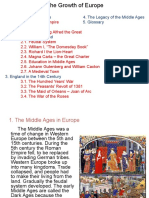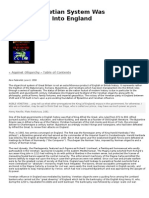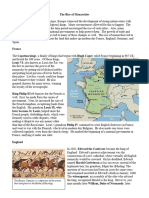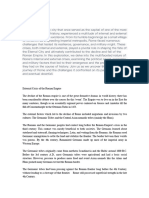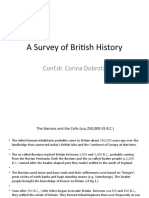UAE SST Summary
UAE SST Summary
Uploaded by
hanjanabcCopyright:
Available Formats
UAE SST Summary
UAE SST Summary
Uploaded by
hanjanabcCopyright
Available Formats
Share this document
Did you find this document useful?
Is this content inappropriate?
Copyright:
Available Formats
UAE SST Summary
UAE SST Summary
Uploaded by
hanjanabcCopyright:
Available Formats
UAE S.S.T.
Summaries
AFTER THE FALL OF THE ROMAN EMPIRE
In the early centuries of the Common Era, the Roman Empire was the
largest in the world, stretching from England to the River Euphrates in
Iraq. It unified various peoples under Roman rule, but only male citizens
who owned land could participate in the government, while common
people faced heavy taxes and few privileges. This period, known as the
Pax Romana, helped maintain control but led to growing dissatisfaction
among the conquered people. The Empire faced external threats from
tribes referred to as Barbarians. Around 376 CE, the Goths attacked,
leading to significant battles, including the Battle of Hadrianopolis in
378 CE, where Emperor Valens was killed. In 410 CE, the Goths stormed
Rome, taking much of its wealth. At the same time, the Huns, led by
Attila, attacked eastern territories. After Attila's death in 453 CE, other
Germanic tribes, such as the Visigoths, Franks, Suevi, and Vandals,
gradually gained control over important Roman provinces, contributing
to the decline of the Western Roman Empire.
The Republic of Venice
Venice is a small city in Italy made up of over one hundred small
islands, utilizing rivers and boats for transportation instead of streets
and cars. In the High Middle Ages, Venice was a wealthy and influential
maritime power, controlling much of the Adriatic and Aegean Seas by
the 12th century CE. The city's wealth came from its trading
relationship with Egypt and other Middle Eastern countries. The
Venetian maritime fleets, called galleys, were large ships with more
than one hundred oarsmen and armed soldiers on deck, serving as
powerful protectors of the Byzantine Empire’s seas. In 1082, the
Byzantine Emperor Alexios I Komnenos signed a treaty with Venice,
allowing Venetians to enjoy free trade throughout the empire without
tariffs in exchange for their help against the Normans. The Venetians
controlled important ports, such as Constantinople, and developed a
strong relationship with Egypt, becoming its exclusive European trading
partner for spices and other goods.
The Late Middle Ages (100 YEARS OF WAR)
The 12th century CE was marked by instability and conflict in Europe,
particularly between England and France, during the period known as
the First Hundred Years’ War (1159 CE to 1259 CE). The Plantagenet
family ruled most of England and owned a significant amount of land in
France, while the Capet family sought to regain control of their
territories. Henry II, King of England from 1154 CE, expanded England’s
territory in France, leading to several major battles. Philip Augustus
became King of France in 1180 CE and fought back, persuading Henry's
son, Richard, known as Richard the Lionheart, to help him. After Henry's
death in 1189 CE, Richard became King of England, but conflict
continued as Philip attacked English lands. John, Richard’s brother,
became King of England in 1199 CE after Richard's death, and over the
next 50 years, France won many battles. In 1215, John signed the
Magna Carta, which protected the rights of wealthy landowners, but he
failed to follow its rules, leading to conflict. The First Hundred Years’
War ended in 1259 with the Treaty of Paris, signed by Henry III, John’s
son, and King Louis IX of France, where Henry III agreed to give up many
lands in France.
Crisis of the middle Ages
During the Late Middle Ages, Europeans faced significant challenges
beyond warfare, including natural disasters. One major disaster was the
Great Famine of 1315-17 CE, which struck after a long period of growth
and prosperity. A shift in climate resulted in cooler temperatures and
shorter growing seasons, referred to as the Little Ice Age. Heavy rains in
the spring of 1315 caused widespread flooding that damaged stored
grains, leading to poor crop yields and skyrocketing food prices,
particularly in France. Millions of people starved, and some historians
estimate that the famine killed up to 25% of Europe’s population.
The following crisis was the bubonic plague, known as the Black Death,
which struck from 1347 to 1351. This devastating disease spread
quickly in crowded cities with poor hygiene, caused by bacteria carried
by fleas living on rodents. The Black Death is estimated to have killed up
to 200 million people, accounting for a third to half of Europe's
population in just four years. Despite the immense suffering, the
aftermath of the plague led to improved living standards, as wages
increased and the prices of food and goods decreased.
You might also like
- Part 1 Chief Events and Developments in The British HistoryNo ratings yetPart 1 Chief Events and Developments in The British History11 pages
- The Decline of The Western Roman Empire Final EssayNo ratings yetThe Decline of The Western Roman Empire Final Essay9 pages
- The Plan:: 1. Middle Ages in Europe 4. The Legacy of The Middle Ages 5. GlossaryNo ratings yetThe Plan:: 1. Middle Ages in Europe 4. The Legacy of The Middle Ages 5. Glossary39 pages
- Engels Literatuur Samenvatting The Middle AgesNo ratings yetEngels Literatuur Samenvatting The Middle Ages8 pages
- Identification and Reasons For The Fall of The Roman EmpireNo ratings yetIdentification and Reasons For The Fall of The Roman Empire12 pages
- How The Venetian System Was Transplanted Into EnglandNo ratings yetHow The Venetian System Was Transplanted Into England8 pages
- A Century of Crisis. Historians Generally Agree That The End of The Reign of TheNo ratings yetA Century of Crisis. Historians Generally Agree That The End of The Reign of The3 pages
- Chapter 3 An Empire Across Three Continents 1No ratings yetChapter 3 An Empire Across Three Continents 19 pages
- Jacques LE Goff - Medieval Civilization.2No ratings yetJacques LE Goff - Medieval Civilization.2412 pages
- Early Modern History Notes. UNIME 1st YearNo ratings yetEarly Modern History Notes. UNIME 1st Year20 pages
- An Empire Across Three Continents Chapter 3No ratings yetAn Empire Across Three Continents Chapter 311 pages
- Lecture Four Origines of The British People3 Thenormans and The Middle AgesNo ratings yetLecture Four Origines of The British People3 Thenormans and The Middle Ages3 pages
- Imperialism As A Cause of World War I: Key FactsNo ratings yetImperialism As A Cause of World War I: Key Facts3 pages
- A Survey of British History: Conf - Dr. Corina DobrotăNo ratings yetA Survey of British History: Conf - Dr. Corina Dobrotă17 pages
- Castrum to Castle: Classical to Medieval Fortifications in the Lands of the Western Roman EmpireFrom EverandCastrum to Castle: Classical to Medieval Fortifications in the Lands of the Western Roman Empire5/5 (1)
- CLASSIMAT Formet - USTER - QCD-Format-No-64No ratings yetCLASSIMAT Formet - USTER - QCD-Format-No-641 page
- Course Outline - UPEACE FOUNDATION COURSE UPM 6001 - PGD 100No ratings yetCourse Outline - UPEACE FOUNDATION COURSE UPM 6001 - PGD 1004 pages
- 23-24 S5 CS (Term 1) Theme 2 - Topc 1 WS3 - TNo ratings yet23-24 S5 CS (Term 1) Theme 2 - Topc 1 WS3 - T17 pages
- Engineering Ethics - Concepts and Caces - Cases OnlyNo ratings yetEngineering Ethics - Concepts and Caces - Cases Only52 pages
- German Foreign Policy: International Relations 1871 - 1914No ratings yetGerman Foreign Policy: International Relations 1871 - 191420 pages
- A Process That Has Five Stages: Potential Opposition or Incompatibility, Cognition and Personalization, Intentions, Behavior, and OutcomesNo ratings yetA Process That Has Five Stages: Potential Opposition or Incompatibility, Cognition and Personalization, Intentions, Behavior, and Outcomes3 pages
- Week 9 Lecture Slides Sydney-LogicOfSurvival2022No ratings yetWeek 9 Lecture Slides Sydney-LogicOfSurvival202235 pages
- Les Chiens de Tindalos Par Franck Belknap LongNo ratings yetLes Chiens de Tindalos Par Franck Belknap Long29 pages
- World Challenge Day 1: 3rd Run Results: GlasgowNo ratings yetWorld Challenge Day 1: 3rd Run Results: Glasgow24 pages
- Clandestine Photography (Raymond P. Siljander, Lance W. Juusola) (Z-Library)No ratings yetClandestine Photography (Raymond P. Siljander, Lance W. Juusola) (Z-Library)673 pages




